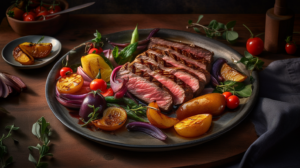Do you ever wonder why some people seem to effortlessly maintain a healthy weight while others struggle to shed those extra pounds? Well, here’s an interesting statistic for you: Did you know that the thermic effect of food can account for up to 10% of your daily energy expenditure?
That means that the simple act of eating can actually help you burn calories! In this article, we’ll dive deep into the fiery impact of food and explore how understanding the thermic effect can unlock the secrets to a faster metabolism.
So, what exactly is the thermic effect of food? It refers to the energy expenditure your body requires to digest, absorb, and metabolize the food you eat. In simpler terms, it’s the number of calories your body burns just by processing the food you consume.
This fascinating process can vary depending on the type of food you eat, with protein having the highest thermic effect, followed by carbohydrates and then fats. By understanding how different foods impact your metabolism, you can make more informed choices about what you eat and how it affects your weight.
What is the Thermic Effect of Food?
While you already know that food provides energy, have you ever considered the additional energy your body expends to digest, absorb, and process the nutrients from the food?
This additional energy expenditure is known as the thermic effect of food. It is the amount of calories burned during the process of food digestion and metabolism.
When you eat, your body has to work to break down the food into its basic components, such as carbohydrates, proteins, and fats. This process requires energy, which is measured in calories.
The thermic effect of food varies depending on the macronutrient composition of the meal. For example, protein has a higher thermic effect compared to carbohydrates and fats. This means that when you consume protein-rich foods, your body burns more calories during digestion and metabolism.
Understanding the thermic effect of food is crucial because it can impact your overall energy balance and metabolism. By choosing foods with a higher thermic effect, you can potentially increase the amount of calories burned during digestion and support your weight loss or weight maintenance goals.
How Does the Thermic Effect Affect Metabolism?
Imagine yourself sitting down to a delicious meal, and the way your body responds to the food you consume plays a significant role in how efficiently it burns calories. This is where the thermic effect of food comes into play. The thermic effect refers to the increase in energy expenditure that occurs after eating, as your body works to digest, absorb, and process the nutrients from your meal. This process actually requires energy, and the thermic effect can vary depending on the type of food you consume.
To understand how the thermic effect affects metabolism, let’s take a closer look at the different macronutrients and their corresponding thermic effect percentages:
| Macronutrient | Thermic Effect Percentage |
|---|---|
| Protein | 20-35% |
| Carbohydrates | 5-10% |
| Fat | 0-3% |
As you can see from the table, protein has the highest thermic effect, requiring your body to burn more calories to digest and process it. This means that by consuming protein-rich foods, you can actually increase your metabolism and burn more calories throughout the day. Carbohydrates, on the other hand, have a lower thermic effect, meaning that your body doesn’t have to work as hard to process them. Finally, fat has the lowest thermic effect, requiring the least energy for digestion.
Understanding the thermic effect of food and its impact on metabolism can help you make more informed choices about the types of foods you consume. By incorporating more protein into your diet, you can give your metabolism a boost and increase calorie burning. So next time you sit down to a meal, consider the thermic effect and choose foods to help your body efficiently burn calories.
Factors Influencing the Thermic Effect
Explore the factors that can influence the thermic effect and discover how they can spark a metabolic fire within you.
Your body is a complex machine, and how it processes food plays a key role in your overall metabolism. The thermic effect of food refers to the energy required by your body to digest, absorb, and process the nutrients from the food you eat.
But did you know that certain factors can actually increase this thermic effect, leading to a higher metabolic rate?
One of the factors that can influence the thermic effect is the type of food you consume. Protein-rich foods, for example, have a much higher thermic effect than carbohydrates or fats. This means that when you eat protein, your body has to work harder to break it down and extract the nutrients, resulting in a higher calorie burn. So, if you want to kickstart your metabolism, consider incorporating more lean meats, poultry, fish, and legumes into your diet.
Another factor that can influence the thermic effect is the frequency and size of your meals. Eating smaller, more frequent meals throughout the day can actually increase your metabolic rate. This is because your body has to constantly digest and process the food, keeping your metabolism active. On the other hand, consuming large meals infrequently can cause your metabolism to slow down, as your body doesn’t have to work as hard to process the food. So, if you want to keep that metabolic fire burning, try spreading your meals out and opt for smaller, nutrient-dense options.
By understanding the various factors that can influence the thermic effect, you can ignite a metabolic fire within you. So, go ahead and choose protein-rich foods, eat smaller, more frequent meals, and watch as your metabolism starts to soar.
Maximizing the Thermic Effect for Weight Loss
To maximize your weight loss, you need to focus on increasing the amount of energy your body burns when digesting and processing the food you eat. This is known as the thermic effect of food, and it can play a significant role in helping you shed those extra pounds.
The thermic effect refers to the energy expenditure required to digest, absorb, and process the nutrients in the food you consume. By choosing foods that have a higher thermic effect, you can effectively boost your metabolism and burn more calories throughout the day.
One way to maximize the thermic effect for weight loss is to incorporate protein-rich foods into your diet. Protein has the highest thermic effect of all the macronutrients, meaning that your body burns more calories when digesting and metabolizing protein than carbohydrates or fats. By including lean protein sources such as chicken, fish, tofu, and legumes in your meals, you can increase the thermic effect and promote weight loss.
Additionally, adding spices and herbs to your meals can also help maximize the thermic effect. Certain spices, such as cayenne pepper, ginger, and cinnamon, have been shown to increase metabolism and enhance the thermic effect temporarily. These spices can also flavor your dishes, making them more enjoyable and satisfying.
Does Cooking Methods Affect the Thermic Effect of Food on Metabolism?
The debate over heating food in microwaves and its impact on the thermic effect of food on metabolism continues. While some believe that microwaving food can reduce its thermic effect, others argue that the difference is minimal. Further research is needed to determine the true impact of this cooking method.
The Role of Exercise in Enhancing the Thermic Effect
Get ready to kick your metabolism into high gear with exercise, because it’s like adding fuel to a fire! When it comes to enhancing the thermic effect of food, exercise plays a crucial role in revving up your metabolism and helping you burn more calories. Not only does exercise increase your heart rate and oxygen consumption, but it also stimulates the release of hormones that promote fat burning and muscle growth. So, whether you’re hitting the gym, going for a run, or even just taking a brisk walk, you’re giving your metabolism the boost it needs to work harder and more efficiently.
To better understand the impact of exercise on the thermic effect, let’s take a look at the table below:
| Exercise Type | Calories Burned per Hour | Intensity Level |
|---|---|---|
| Running | 600-900 | High |
| Cycling | 400-700 | Moderate |
| Walking | 200-400 | Low |
| Weightlifting | 300-500 | High |
| HIIT | 500-800 | High |
As you can see, the more intense the exercise, the more calories you burn. High-intensity exercises like running, weightlifting, and HIIT (high-intensity interval training) can significantly increase your metabolic rate and the thermic effect of food. However, even low-intensity exercises like walking can still have a positive impact on your metabolism. So, whether you prefer high-intensity workouts or enjoy a leisurely stroll, any exercise can help enhance the thermic effect and support your weight loss goals.
By incorporating regular exercise into your routine, you’re not only adding fuel to the fire of your metabolism but also taking a step towards serving your own health and well-being. So, lace up those sneakers, grab a buddy if you’d like, and get moving! Your body will thank you for it, as you’ll be on your way to maximizing the thermic effect and achieving your weight loss goals. Remember, every step counts, and every effort you make serves your ultimate desire for a healthier, happier you.
Frequently Asked Questions
Is the thermic effect of food the same for all types of foods?
The thermic effect of food varies depending on the type of food you consume. Some foods, like protein, have a higher thermic effect compared to others, such as carbohydrates or fats.
Can the thermic effect of food vary from person to person?
Yes, the thermic effect of food can vary from person to person. Just like how we all have different tastes, our bodies also have unique metabolic rates that can influence how much energy we burn from eating.
Does the thermic effect of food increase with the amount of food consumed?
Yes, the thermic effect of food does increase with the amount you consume. When you eat more, your body has to work harder to digest and metabolize the food, resulting in a higher thermic effect.
Are there any specific foods that have a higher thermic effect than others?
Yes, there are indeed specific foods that can ignite your metabolism like a blazing inferno! These fiery delights, such as chili peppers and protein-rich meats, can supercharge your body’s thermic effect and help you burn calories like never before.
Can cooking methods influence the thermic effect of food?
Yes, the thermic effect of food can be influenced by cooking methods. Cooking techniques like grilling and broiling can increase the thermic effect by promoting the breakdown of proteins, while frying can decrease it due to added fats.














